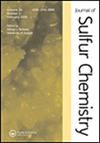Experimental study of hydrogen sulfide (H2S) behavior in brine/n-decane mixtures under HPHT conditions
IF 1.6
3区 化学
Q3 CHEMISTRY, MULTIDISCIPLINARY
引用次数: 0
Abstract
This research investigates the dynamic behavior of hydrogen sulfide (H2S) under oil reservoir conditions, focusing on their interplay within both aqueous and organic phases. Surprising findings emerge, notably the heightened solubility of H2S at 250°C compared to 150°C, with values of 19.9 mg to 41.5 and 12.8 mg to 16.4 mg in 100ml of solution, respectively, diverging from conventional expectations, due to organosulfur compounds generated at the water/n-decane interface under high pressure and temperature conditions. Through an examination of Henry's Law and the calculation of Henry's constants across several temperatures, insights into these observations are gained. In the organic phase, temperature is observed to catalyze the formation of organosulfur compounds from n-decane and H2S. Notable compounds identified include aromatic hydrocarbons bearing sulfur substituents. highlighting the presence of 2-Propyldibenzothiophene (2 – 392 mg/mL), which represents between 57 and 95% of the total concentration of organosulfur compounds found in the organic fraction, being more abundant at 250°C. These findings underscore the intricate interplay between temperature, pressure, and phase composition, elucidating the nuanced solubility patterns and reaction dynamics of sulfur and organosulfur compounds.
高温条件下卤水/正癸烷混合物中硫化氢(H2S)行为的实验研究
本研究研究了油藏条件下硫化氢(H2S)的动态行为,重点研究了它们在水相和有机相中的相互作用。令人惊讶的发现是,与150°C相比,H2S在250°C时的溶解度更高,在100ml溶液中分别为19.9 mg至41.5 mg和12.8 mg至16.4 mg,这与传统的预期不同,这是由于高压和高温条件下在水/正癸烷界面产生的有机硫化合物。通过对亨利定律的检验和对不同温度下亨利常数的计算,对这些观察结果有了深入的了解。在有机相中,温度对正癸烷和H2S生成有机硫化合物有催化作用。已确定的主要化合物包括含硫取代基的芳烃。突出了2-丙基二苯并噻吩(2 - 392 mg/mL)的存在,占有机馏分中有机硫化合物总浓度的57%至95%,在250°C时含量更高。这些发现强调了温度、压力和相组成之间复杂的相互作用,阐明了硫和有机硫化合物的细微溶解度模式和反应动力学。
本文章由计算机程序翻译,如有差异,请以英文原文为准。
求助全文
约1分钟内获得全文
求助全文
来源期刊

Journal of Sulfur Chemistry
CHEMISTRY, MULTIDISCIPLINARY-
CiteScore
4.10
自引率
9.10%
发文量
38
审稿时长
6-12 weeks
期刊介绍:
The Journal of Sulfur Chemistry is an international journal for the dissemination of scientific results in the rapidly expanding realm of sulfur chemistry. The journal publishes high quality reviews, full papers and communications in the following areas: organic and inorganic chemistry, industrial chemistry, materials and polymer chemistry, biological chemistry and interdisciplinary studies directly related to sulfur science.
Papers outlining theoretical, physical, mechanistic or synthetic studies pertaining to sulfur chemistry are welcome. Hence the target audience is made up of academic and industrial chemists with peripheral or focused interests in sulfur chemistry. Manuscripts that truly define the aims of the journal include, but are not limited to, those that offer: a) innovative use of sulfur reagents; b) new synthetic approaches to sulfur-containing biomolecules, materials or organic and organometallic compounds; c) theoretical and physical studies that facilitate the understanding of sulfur structure, bonding or reactivity; d) catalytic, selective, synthetically useful or noteworthy transformations of sulfur containing molecules; e) industrial applications of sulfur chemistry; f) unique sulfur atom or molecule involvement in interfacial phenomena; g) descriptions of solid phase or combinatorial methods involving sulfur containing substrates. Submissions pertaining to related atoms such as selenium and tellurium are also welcome. Articles offering routine heterocycle formation through established reactions of sulfur containing substrates are outside the scope of the journal.
 求助内容:
求助内容: 应助结果提醒方式:
应助结果提醒方式:


